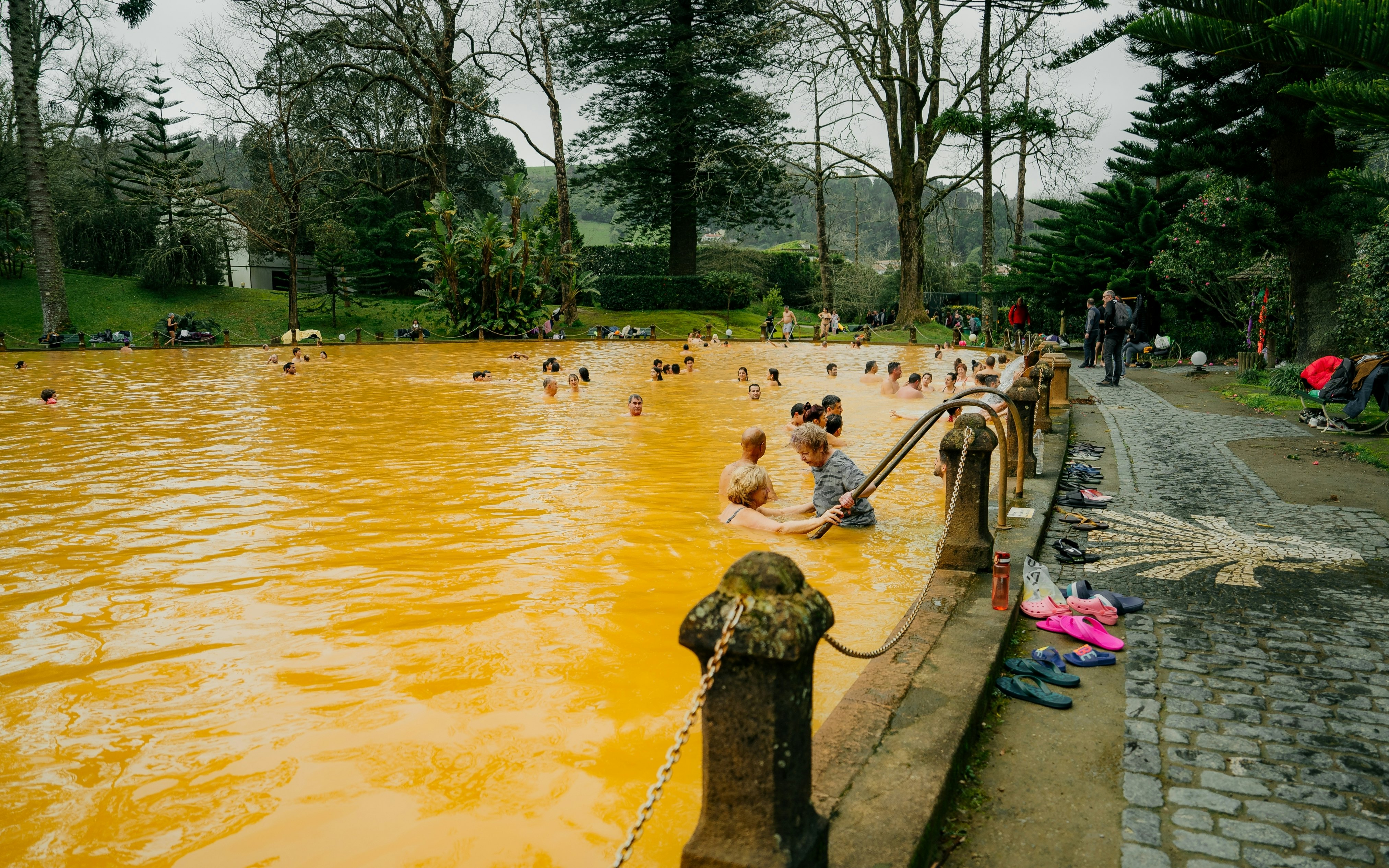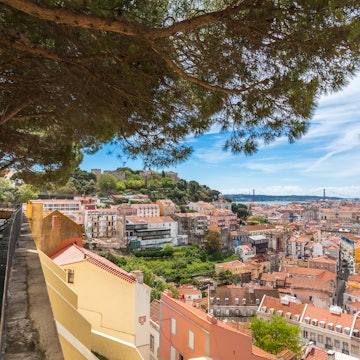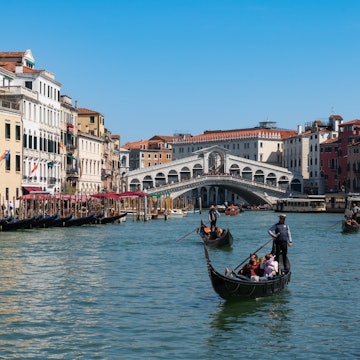

Piscina de Caloura, a pool built into the Atlantic, in São Miguel. ABB Photo/Shutterstock
Outlandish hikes and otherworldly landscapes, verdant calderas and volcanic vines, thermal springs and theatrical cascades – the Azores are everything magical and then a little more.
Simultaneously an adventurer's arcadia, an oenophile's fantasyland, a restorative utopia and an all-around idyll, Portugal's Atlantic-scattered, autonomous archipelago serves up a volcano-steamed smorgasbord of superlative experiences at every oh-so green turn.
Expect lava-fashioned terrain, wonder-inducing walks and whale watching as the standard across the nine main islands. But whittling down which location-specific adventures – in São Miguel, thermal springs triumph, while Pico rules wine supreme – to squeeze into your island-hopping itinerary is another story. Fear not: our picks of the top things to do in the Azores will help you plan the perfect first visit – and perhaps a second and third.
1. Hike between São Jorge’s heights and oceanside fajas
Drop yourself anywhere in the Azores and you’ll land close to an epic trail. Rugged, cinematic and climb-worthy islands are a hiker’s catnip, but slender, soaring São Jorge steals the foot-forward show, thanks to its fajas, the jutting coastal flats predominantly formed from lava spills.
Most dazzling is the PR01 SJO. A moderate 9.5km (6-mile) one-way trail of endless emerald slopes cascading to the cobalt Atlantic Ocean. From Serra do Topo, follow the well-worn tracks zigzagging through seasonal perfumed hydrangeas and vivid vegetation to the lake-harboring Fajã da Caldeira de Santo Cristo, one of the island’s most remote settlements and surf spots. Pause to picnic here before continuing to the equally breathtaking Fajã dos Cubres, best relished from the miradouro (lookout) higher on the road. Time to spare? The 92km (57-mile) Great Trail traverses the island’s breadth.
Planning tip: As most of São Jorge’s hikes are linear – and some fajas aren’t accessible to vehicles – consider traveling without a car. Twice-daily commuter buses (there’s no website or Sunday service) can be handy for posthike returns. Otherwise, prebook taxis to get you to and from the trailheads. Outside of summer, weather can shutter trail sections.

2. Marvel at the subterranean world in a lava tube
Weaving just below the Azores’ surface is a world of tunnels formed by fast-flowing lava flows that created roofed cavities after cooling. Dark, dramatic and utterly fascinating, these eruption-assembled lava tubes are one of the Azores’ more unique geographical features, and you can don a hard hat and headlamp to tour deep within. At Portugal’s longest lava tube, Gruta das Torres in Pico, guided visits afford the chance to climb down a volcanic pit and walk 450m (1476ft) into an unlit world of lava stalactites and stalagmites. It’s phenomenal. Find similar tours at Terceira’s Gruta do Nata and São Miguel’s Gruta do Carvão.
Detour: Understand more about the nine islands’ eruption timelines and sway atop a seismic simulator at Pico’s informative Casa dos Vulcões.
3. Kayak across Sete Cidades’ twin iridescent lakes
Twinkling in shades of turquoise, teal and sapphire, Sete Cidades’ pair of spectacular volcanic crater lakes is the kind of sight that panorama postcards were invented for. Admire every outlandish angle on the 11.8km (7.3-mile) Mata do Canário trail, which largely clings to the crater’s rim before descending to the village. En route, creatively named Lagoa Verde (Green Lake) and Lagoa Azul (Blue Lake) – technically one lagoon – dazzle in every imaginable hue. But don’t rush off. Rent a kayak or paddleboard to enjoy a serene hour or two gliding across the calm waters away from the congested miradouros.
Detour: São Miguel is not short of astonishing lakes. Lagoa do Fogo, Lagoa do Congro and Lagoa das Furnas are all remarkable.

4. Soothe mind and soul in garden-shrouded thermal springs
After all that hiking, nothing beats slipping into one of São Miguel’s soothing natural thermal springs. Fed by the Furnas Valley’s geothermal activity, a clutch of alfresco pools provides the perfect rejuvenation, courtesy of Mother Nature. Take your pick from Parque Terra Nostra's murky, mineral-rich 42ºC (108ºF) waters hemmed by exotic gardens, plonk yourself in Poça da Dona Beija’s palm-shaded pools, or choose cascade-fed Centro de Interpretação Ambiental da Caldeira Velha. Plan for a first-thing visit to avoid the cruise passenger rush.
Detour: Continue your São Miguel thermal journey along the coast. Clamber into the craggy rock pool at Ponta da Ferraria, heated by thermal springs below, or dig your feet into the sand at Praia do Fogo until you find a hydrothermal vent.
5. Watch whales breach and be a marine biologist for a day
Considered one of the world’s largest whale sanctuaries, the waters around the Azores are a cetacean playground. Resident sperm whales and numerous migrant species ensure reliable year-round whale watching, and witnessing these magnificent marine mammals breaching and blowing – along with playful pods of dolphins – is a quintessential Azores’ experience.
If you’re lucky, you might glimpse a tail from an interisland ferry. But booking a dedicated excursion will almost always guarantee a sighting. Trips depart from all of the islands but Corvo, and joining a marine biologist-led outing also supports conservation and research. Tour operator Futurismo even offers the possibility of assisting scientific sailings for a deeper education.
Detour: Learn about the Azores’ former whaling industry (illegal since the 1980s) at Pico’s Museu dos Baleeiros or Faial’s Museu Fábrica da Baleia de Porto Pim.

6. Fearlessly face Flores’ falls on a canyoning adventure
While it might figure that the wettest, westernmost island is best bypassed, Flores’ precipitation makes it arguably the archipelago’s prettiest member. This evergreen land of gossamer waterfalls and mirrorlike lakes – Poco da Ribeira do Ferreiro blends both with perfection – will make your heart sing. Or scream if you go canyoning. With rappelling routes suitable for first-timers and full-fledged canyoneers, the area around Ribeira Grande stands out for waterfalls, rock-carved slides and refreshing pools. Come in spring for the most ethereal scenes.
Detour: Find more canyoning-ready crashing waterfalls in São Miguel's Ribeira dos Caldeirões.
7. Tackle the challenging climb up Portugal’s highest peak
Crowning its namesake island, conical Mt Pico protrudes like an Atlantic Ocean waypoint. From nearly every point on the island – and from neighboring Faial and São Jorge – the dormant stratovolcano dominates the horizon at 2351m (7713ft). Up for a challenge? Embark on the steep, exhausting ascent to Portugal’s highest point. Plan to take at least eight hours and be prepared for all weather eventualities (a sudden shift isn’t uncommon).
For a more extraordinary journey, join a guided night climb to camp atop the peak. Staring up at the constellations on a clear night while cocooned in the chilly crater is almost supernatural, as is seeing the sunrise from the summit, Piquinho.
Planning tip: While Pico can be hiked unaccompanied, climbing with a guide is highly recommended due to potential weather changes and fog. The trail has a daily cap of 320 people, and all hikers must register online and declare their safe return. Overnight stays have additional conditions and are limited to 32 people.

8. Cross the ash-strewn landscape around the Capelinhos Volcano
When the Capelinhos Volcano started erupting in 1957, the island of Faial was forever changed. For 13 months, the submarine volcano growled, spewed and swelled, and by the time it was finished, thousands of Faialense had immigrated to the US and their home island had enlarged by 2.4 sq km (593 acres).
Walking across this barren, bleak landscape to the Ponta dos Capelinhos Lighthouse – no longer directly oceanside due to the extension – will put the effect of seismic activity into perspective like nowhere else in the Azores. Once you’ve lifted your jaw off the ashy floor, visit the adjoining interpretation center to learn more.
Detour: It’s easy to explore compact Faial’s highlights in one day by e-bike. Cycle to the verdant caldera’s rim before heading to Horta’s marina to see maritime street art left by sailors, take a dip at Praia do Porto Pim and sip an island-made gin at sunset at the local institution Peter Café Sport.
9. Amble along Angra do Heroismo’s handsome historic center
Few come to the Azores for a city break, but Terceira’s largest burg, Angra do Heroismo, has enough allure to win over even the most hardened urban cynic. Spend an afternoon ambling along the basalt cobblestone streets, admiring the ubiquitous and colorfully embellished impérios (temples dedicated to the Holy Spirit) and monuments honoring Portugal's navigators – Angra was an Atlantic Ocean anchor point during the Age of Discovery – and you’ll soon be smitten.
Still, this is the Azores, so Angra’s most striking feature isn’t urban but Monte Brasil, a hulking extinct volcano that rose from the Atlantic some 20,000 years ago. The protected park is accessed via weathered fortresses standing guard since the 16th century.
Detour: Atlânticoline's ferries depart twice weekly in summer from Angra do Heroismo to the often overlooked island of Graciosa. As with interisland flights, the whims of the Atlantic’s weather can dictate delays and cancellations – a little itinerary flexibility is a must.


10. Pour a fresh cuppa at a tea plantation
Catherine of Braganza, a Portuguese princess, introduced tea to the British in the 17th century, and since the mid-1800s, Portugal has been growing and brewing its own in the Azores, Europe’s only commercial tea plantations. On São Miguel’s north coast, Gorreana and Porto Formoso are just a 30-minute walk apart (2.3km, or 1.4 miles). Head to either to stroll the scenic, unrestricted pathways weaving through manicured rows of plants before popping into the factory (no reservations required) for a tour and pour.
Detour: Prefer an Atlantic cup of joe? One of the few coffee farms in Europe is found at Fajã dos Vimes in São Jorge; drive or hike the PR09 SJO to the family-owned Café Nunes for an at-the-source taste.
11. Sip your way through Pico’s stupendous volcanic wines
A vast patchwork of painstakingly constructed currais (wind-protecting walls built with hewed black basalt) tells the story of Pico’s 15th-century vineyards. It’s almost inconceivable that such a harsh landscape could produce first-class vinhos, but even the necessity of chiseling into the earth’s rocky crust to plant the vines couldn’t put off the hardworking vintners. The resulting wines are deliciously mineral and zesty.
To appreciate these wine warriors' handiwork, trace the Paisagem da Vinha de Criação Velha through the currais, Mt Pico looming beyond, and dip into the Museu do Vinho (pausing to appreciate the dragon trees) for a historical overview. Quench your thirst at the long-standing cooperative with a flight of fine wines or visit the interpretation center at Lajido for a taster.
Detour: Pico isn’t the only Azorean island bottling wine; Terceira and Graciosa have regulated production too. Most exciting right now is Santa Maria’s recovered, ocean-facing terraced vines. For decades, you’d need a generous Mariense to pour you a glass of their homemade vinho – that was until a rejuvenation project led to small-batch Céptico receiving certification in 2024.

12. Swim in lava-sculpted pools and surf off black sand beaches
With the fierce Atlantic pounding at the Azores' doorstep, most swimming takes place in the shelter of lava-formed natural pools or artificial lidos. Sao Jorge’s Piscina Natural Simão Dias is one of the best. But that’s not to say the dusky sands aren’t a delight – you just need to pick the best beach for a paddle and keep safety, currents and the occasional Portuguese man o' war in mind. If you don't like sand, Piscina de Caloura is a natural pool on São Miguel, located on a basalt rock cliff and surrounded by vineyards.
Prefer to catch a wave than a tan? The Azores are primed for surfing whether you're a beginner or a pro. Praia do Areal de Santa Bárbara, on São Miguel's north coast, is a cracking place to start with its beach breaks, occasional barrels, a local-led surf school and seasonal lifeguards.
Planning tip: For more typical sands and sheltered bays, spend a few nights in Santa Maria. Not only is it home to two gorgeous golden bays – Praia Formosa and Praia de São Lourenço – but as the southernmost island, it's frequently sunnier and slightly warmer.
13. Circumnavigate far-flung Corvo's crater below migratory birds
Teeny Corvo keeps itself quiet. But if you make the odyssey to the Azores’ smallest inhabited island (there’s a single hamlet), you’ll be treated to hushed hikes, quality birding and a glimpse into the Azores of old. The only real attraction – bar the serenity – is the chance to walk within the wetland-filled collapsed crater of Caldeirão. Before setting off, swing by the Centro de Interpretação de Aves Selvagens do Corvo for a crash course on the multiple endemic and migratory bird species you might see in the biosphere reserve.
Planning tip: Corvo has limited accommodations; if you plan to stay overnight, book well in advance or bring a tent to camp at the free but basic Parque de Campismo. Atlânticoline's 40-minute ferries (Linha Rosa) make day trips from Flores possible, though tickets sell fast; sailings are only on Tuesday and Saturday outside of summer.

14. Savor volcano-steamed stews and “happy cow” cheeses
Eating in the Azores can be as much of an adventure as exploring the islands. Pans of lapas (limpets), pried from ocean-ravaged rocks by hand, are served sizzling. São Jorge’s free-roaming “happy cows” produce world-class cheeses that gain zestiness with age. And Morcela Açoriana, a typical pork blood sausage, is often accompanied by slices of local pineapple. Top billing for distinctive dining unequivocally goes to Cozido das Furnas. Plated in Furnas’ restaurants – bubbling geysers just beyond – this hearty, meat-heavy stew is mounded in a clay pot and placed underground, where volcanic heat steams it for around seven hours. Unfussy Restaurante Tony's prepares one of the best.
Detour: For a home-grown São Miguel dessert, visit the Ananás dos Açores greenhouses just outside Ponta Delgada to taste the Azores’ supersweet pineapples.
15. Snorkel or scuba dive close to a submerged crater
If you ignore the fact that Ilhéu de Vila Franca do Campo Vila pierced the ocean around 5000 years ago, it didn’t take long for the offshore islet with a nearly perfect circular lagoon to become an Instagram star. Following the 2025 ban on swimming in the inner shallows due to deteriorating water quality, there’s less reason to touch land in this nature reserve and more reason to splash around it.
Plan a scuba or snorkeling trip with the Azores Sub Dive Center for a boatside look at the islet before sighting sunken 16th-century cannons and shoals of colorful fish in the reserve’s surrounding waters. Night dives afford a whole new appreciation; plus, you’ll avoid the scramble for tickets to step foot on the islet.
Planning tip: Access to Ilhéu de Vila Franca do Campo itself is only possible between June and October. Just 400 tickets are available daily for the 10-minute sailings, which run hourly; online bookings open 15 days in advance. On sold-out days, it’s worth checking for last-minute availability at the ticket office.















